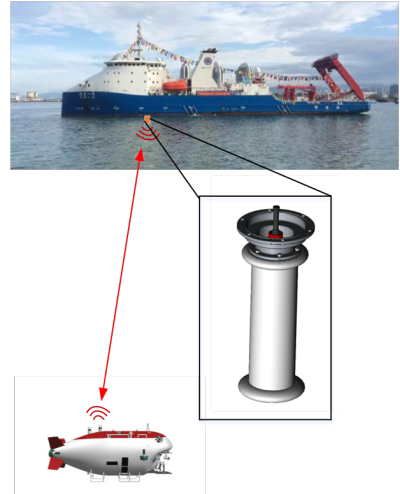
When the manned submersible dives into the deep sea, the acoustic wave, which can penetrate the seawater, becomes the only communication medium between the submersible and its mothership.
However, when the acoustic signal from the seabed reaches the surface, it becomes no longer clear due to the noise pollution caused by the mothership. The traditional solution is to keep the receiving transducer array on the surface away from the noise source, which is inconvenient and unsafe for the operation, especially under extreme sea conditions.
A research team led by Prof. ZHU Min from the Institute of Acoustics (IOA) of the Chinese Academy of Sciences proposed advanced signal processing schemes to overcome the deterioration of signal quality and developed a multi-service communication system between the submersible and the mothership in the shipborne mode. The study was published in China Ocean Engineering.
When designing the communication system of 4500m-depth manned submersible Shenhai Yongshi, Prof. ZHU's team adopted the shipborne mode and found that the in-band noise power was increased by 100 times compared with previous non-shipborne data.
To achieve high-speed communication in the low signal-to-noise ratio condition, researchers employed advanced code modulation and receiving algorithms, with the sparse adaptive turbo equalization algorithm based on turbo code proposed for the coherent transmission.
In the scheme, the sparse decision-directed soft equalizer automatically adjusted the tap pattern and the tap weights according to the varying channel, while the turbo code significantly suppressed the error floor and decreased the turbo equalizer's iteration times.
From the 4680 records of the coherent communication in the 28 dives up to the depth of 4534m in 2017, the failure rate of the coherent frames was 6.13%, where both synchronization errors and decoding errors were taken into account. The error-free transmissions of color images were achieved by the inter-frame error correcting code and the transmission duration of each image was less than 45 seconds.
As the next step, Prof. ZHU's team will further research array signal processing and high spectral-efficiency acoustic communication technology to achieve the high-data-rate multi-service communication of the full ocean depth submersibles.
This research was supported by the National Key Research and Development Program of China, the National Natural Science Foundation of China, and the National High Technology Research and Development Program of China.

Figure.1 Installation of the shipborne array. (Image by IOA)

Figure.2 In-situ images received by the mothership. (Image by IOA)

86-10-68597521 (day)
86-10-68597289 (night)

52 Sanlihe Rd., Xicheng District,
Beijing, China (100864)

